
On 17th September the Loch Lomond and Trossachs National Parks Authority issued a News Release to say they had investigated a case of fly tipping, issued a notice and that a £200 fine had been paid as a result. This is welcome. Its evidence for what I and others have long been saying, that the LLTNPA was totally wrong to claim that the main problems of litter in the National Park were caused by campers and to then use this to con Scottish Ministers into agreeing the camping byelaws.
It will be interesting to see, therefore, if the LLTNPA’s report to Ministers on the camping byelaws this year describe the extensive problems with fly-tipping in the National Park and what they have done about it. Was the incident described in the News Release a one-off, the start of a new initiative or part of a concerted programme of action over the last year? And if the latter is the case why has the LLTNPA been so quiet about it up till now?
This post will take a look at what has been happening at one of the Park’s flytipping hot spots, the Culeag layby on the A82 on the west shore of Loch Lomond, to illustrate the real problem.

Cuileag is also the location for one of the LLTNPA’s camping permit areas which, back in March 2017, was totally unfit for camping (see here). In that post Nick Halls noted that the parking area adjacent to the beach was being used for fly tipping. It still was in June 2017 (see above and below)
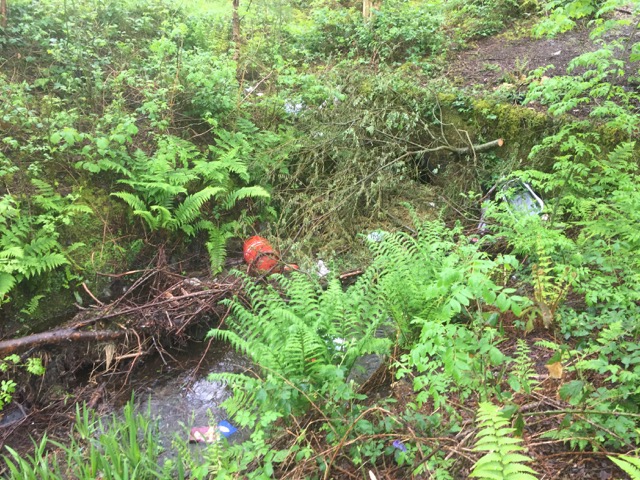
While some of the rubbish may have been dumped by irresponsible campers, it was clear that most of it came from other “irresponsible” sources.
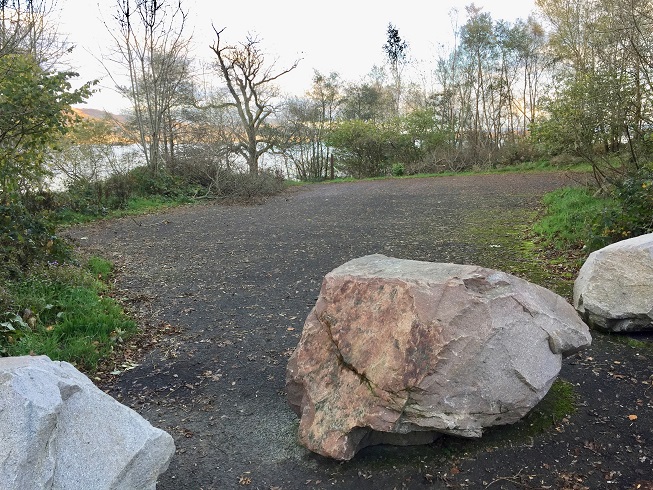
Since then the parking area has been blocked off with boulders – presumably in an attempt to stop the fly-tipping .
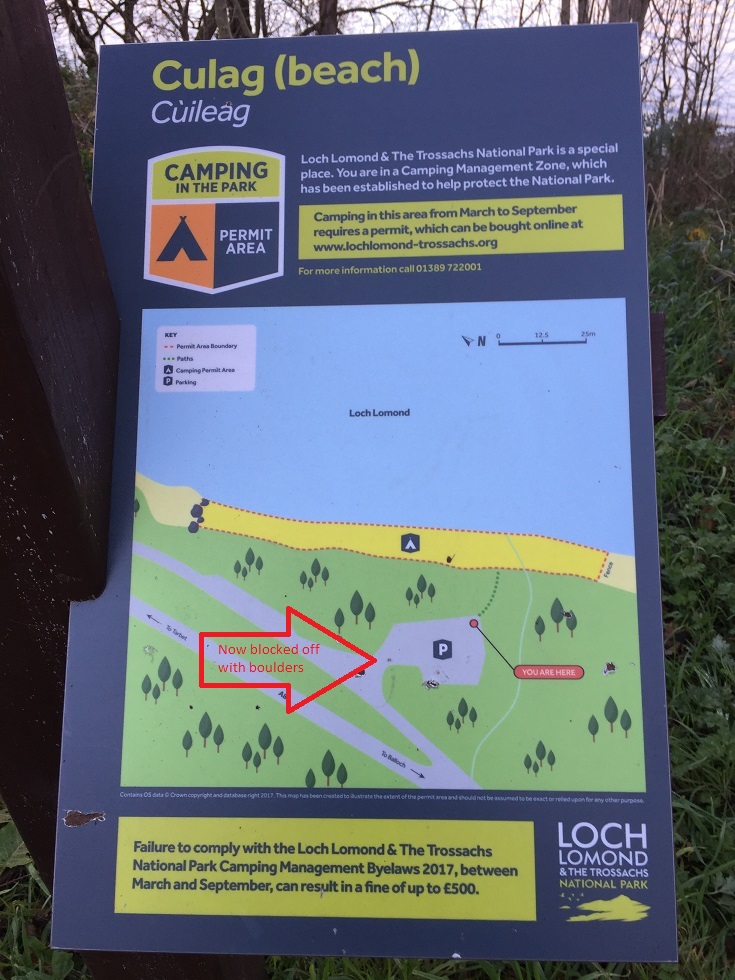
Note how the fine for camping without a permit, however responsibly, is far greater (and incurs a criminal record) compared to the £200 (civil) fixed penalty notices the LLTNPA can issue for fly-tipping. There is something badly wrong here.

Neither the boulders nor the fixed penalty notices have prevented fly-tipping from continuing to take place here. There is no sign to warn people about fly tipping penalties despite the history of fly-tipping on this site. Meanwhile the LLTNPA has spent significant further sums on signage about the camping byelaws, including “repeater” signs (see here). These warn people of the penalties for camping responsibly in places where they used to have the right to camp over the summer. The camping byelaws continue to divert the LLTNPA from the real problems.
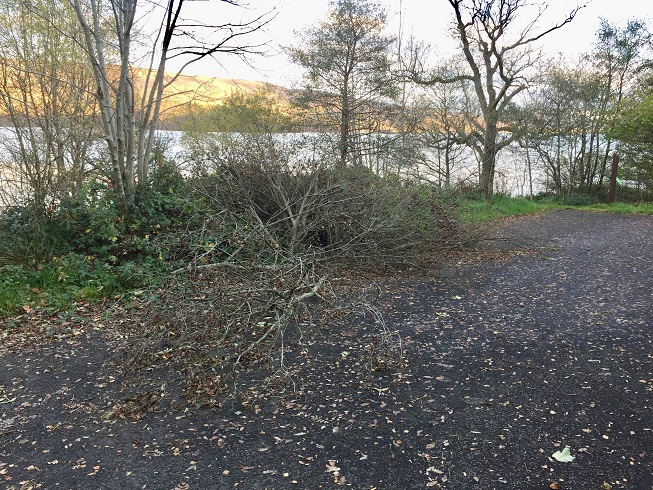
By allowing the former parking area to be blocked off – its not clear if the LLTNPA or the landowner did this – the LLTNPA has in effect allowed a derelict area to be created beside the loch shore. Some, maybe all , of the chopped trees appear to have come from the site but whoever has done the work has dumped piles of branches on the tarmac. Maybe the plan was to remove them?
The blocking off of parking areas which appears to be the LLTNPA’s main strategy when it comes to dealing with the many problems the camping bye-laws have failed to address. In this case there has been little impact on access because, whether a camper or not, you can still park in the main A82 layby. However, if there was an argument for cutting off access here, why not dig up the tarmac and let vegetation reclaim it rather than leaving it to become derelict (and attract yet more fly tipping)?
Is this the sort of high quality visitor infrastructure that our National Parks should be creating and managing in such a beautiful location?
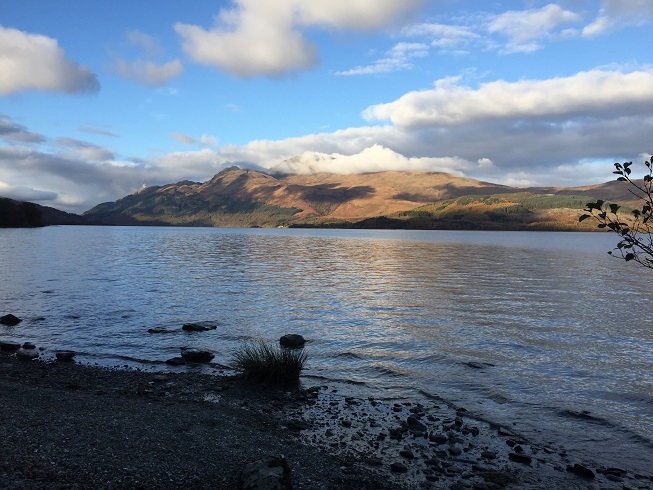
What needs to be done?
The unspoken issue and problem with fly-tipping is that much of it is likely to be done by local residents who are residents of the National Park (people don’t go any further than necessary to fly tip). Just like campers, these irresponsible people are a small minority, but the LLTNPA needs to understand why they dump rubbish. I would suggest it has something to do with the refuse disposal services of local authorities in the area and that, if faced with charges for rubbish disposal, people simply dump it. That is what drives fly-tipping. So, rather than cordoning areas off, the LLTNPA would be far better talking to local councils and asking them to take a look at how they contribute to the issue.
Its precisely because of issues such as this that a third of our National Park Boards are made up of local councillors. Its time Argyll and Bute in particular started to address the real issues instead of punishing visitors with access taxes (see here), camping bye-laws and the like.
According to the SEPA, flytipping is a criminal offence under the Environmental Protection Act 1990 (EPA 1990). I assume if LLTNPA give a fixed penalty fine it’s only a civil offence. I note that as a result of Keep Scotland Beautiful’s audit for the LLTNPA, the Visitor Management Plan running up to 2017 included an intention to create “signage regarding litter policy and disposal” as well as more recycling points. Seems an obvious missed opportunity not to reference fly tipping and the nearest recycle point on the camping permit signs. KSB claims to be “leading the way on improving Scotland’s environment”. Since KSB is a delivery partner in the new “Partnership Plan” and use LLTNPA as a case study for their training in preparation for LLTNPA staff issuing fixed penalty notices for fly tipping, I’d hope that their expertise in this area will become more evident in the future.